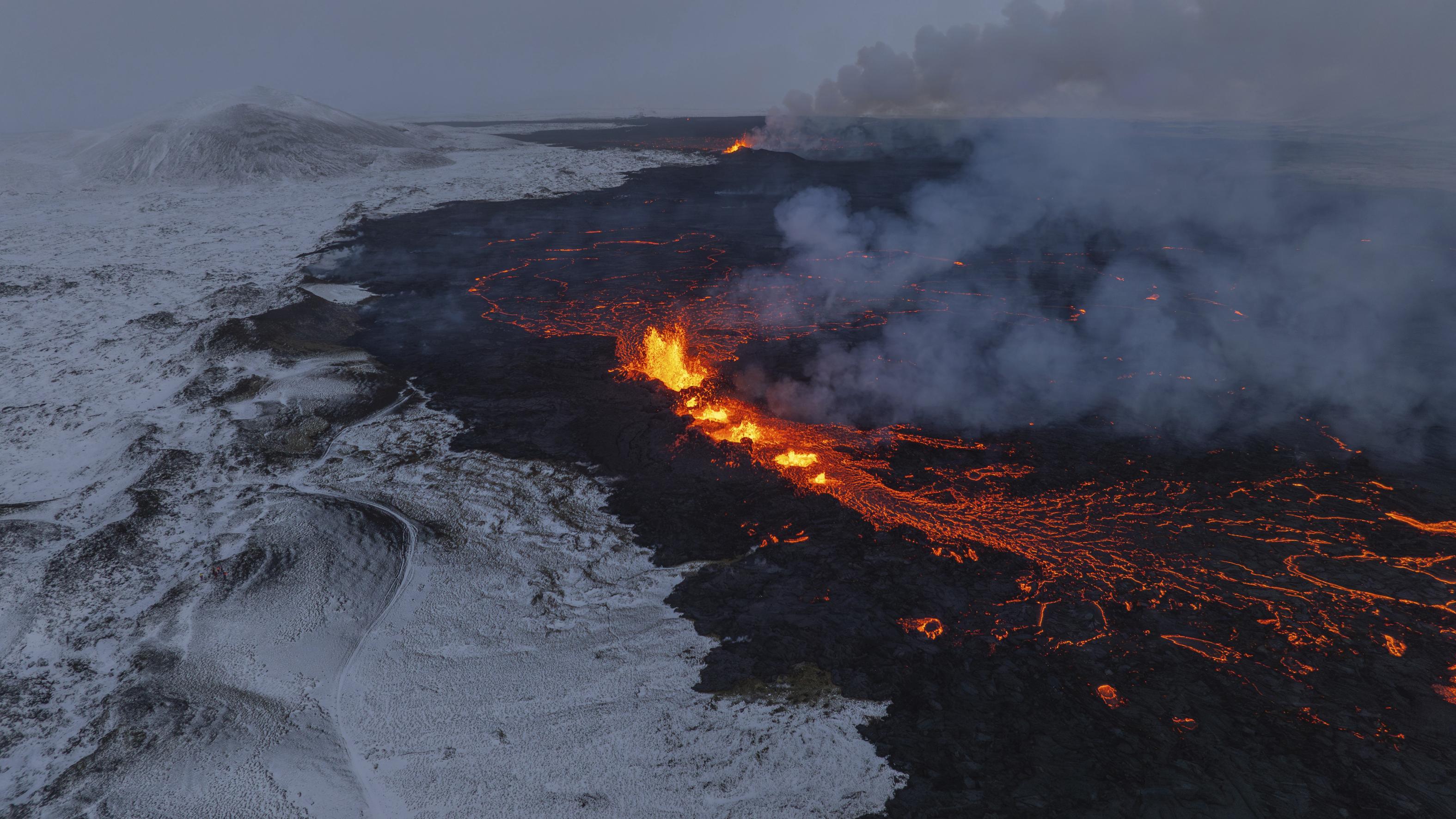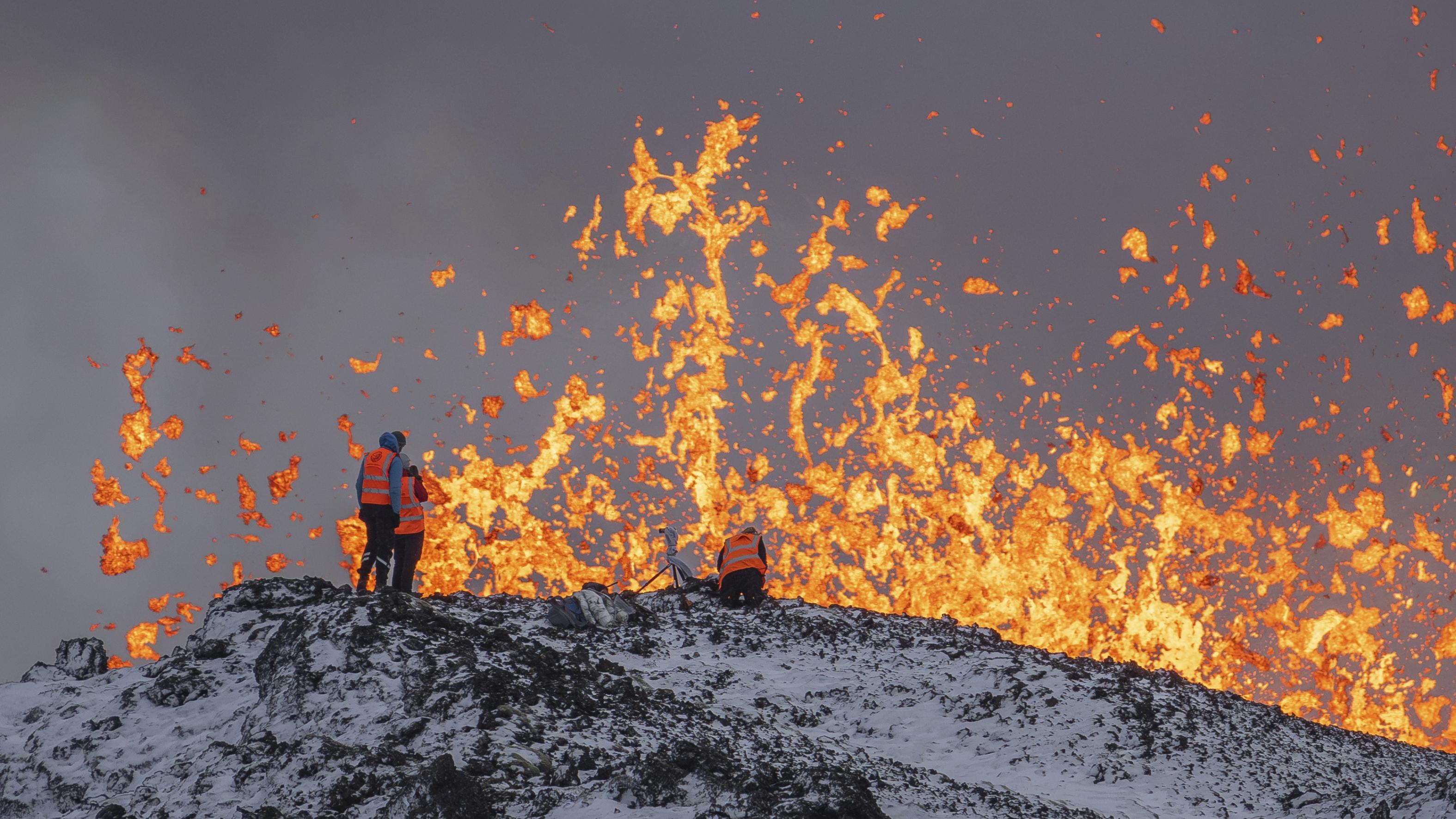 Aerial view of the only two segments of the fissure still active of an active volcano in Grindavik on Iceland's Reykjanes Peninsula, Dec 19, 2023. (PHOTO / AP)
Aerial view of the only two segments of the fissure still active of an active volcano in Grindavik on Iceland's Reykjanes Peninsula, Dec 19, 2023. (PHOTO / AP)
COPENHAGEN — Lava spewing from a volcano in Iceland appeared to be flowing away from the only nearby town and the intensity of the eruption was dropping, offering hope that homes would be safe even though seismic activity could last months, officials said on Tuesday.
The government said flights were unlikely to be affected, quashing international travel concerns lingering after chaos that resulted from the ash cloud caused by an eruption on the north Atlantic island in 2010.
The eruption opened a 4 km (2.5 mile) fissure. But at its southernmost point, the crack was still 3 km away from Grindavik, Iceland's Meteorological Office said, and the power of the volcano was decreasing
The eruption late on Monday on the Reykjanes peninsula in southwest Iceland spewed lava and smoke more than 100 metres (330 feet) into the air after weeks of intense seismic activity.
READ MORE: Iceland volcano erupts after weeks of quake activity
"The eruption does not present a threat to life," a government statement said. "There are no disruptions to flights to and from Iceland and international flight corridors remain open."
Authorities last month evacuated the nearly 4,000 inhabitants of the fishing town of Grindavik about 40 km (25 miles) southwest of capital city Reykjavik, allowing them back intermittently to check on homes put at risk by the tremors.
Kristin Maria Birgisdottir, 43, a Grindavik resident who has been evacuated since Nov 10, at first had a hard time believing it when the volcano erupted.
"Everything happened so fast," said Birgisdottir. "I had already put my kids to sleep, and I was already in bed when I saw someone posted that it had erupted. I took a screenshot, and thought to myself that it was a bad joke."
"We are just waiting for somebody to wake us up or to say cut, the filming is over, because it's so unreal. It's hard to believe this is happening," she later added.
Live footage of the eruption showed bright yellow, orange and red lava in sharp contrast against the sky.
Some tourists were in awe at the spectacle. "Our BnB hosts sent us a message that the volcano has erupted," a tourist from the Netherlands who gave his name as Wouter said. "It's a once in a lifetime for us so we don't want to miss that ... It's a bit far from here, but you can still see some lava coming up, for us this is amazing."
The eruption opened a 4 km (2.5 mile) fissure. But at its southernmost point, the crack was still 3 km away from Grindavik, Iceland's Meteorological Office said, and the power of the volcano was decreasing.
"The eruption is taking place north of the watershed, so lava does not flow towards Grindavik," geologist Bjorn Oddson told public broadcaster RUV.
Gas pollution could still occur in the area of Reykjavik late on Tuesday or Wednesday morning, officials said.
Located between the Eurasian and North American tectonic plates, among the largest on the planet, Iceland is a seismic hot spot because the plates move in opposite directions.
 Scientist of the University of Iceland take measurements and samples standing on the ridge in front of the active part of the eruptive fissure of an active volcano in Grindavik on Iceland's Reykjanes Peninsula, Dec 19, 2023. (PHOTO / AP)
Scientist of the University of Iceland take measurements and samples standing on the ridge in front of the active part of the eruptive fissure of an active volcano in Grindavik on Iceland's Reykjanes Peninsula, Dec 19, 2023. (PHOTO / AP)
The eruption is about 30 km from Reykjavik. Keflavik international airport is somewhat nearer but remains open. The Blue Lagoon, a geothermal spa popular with tourists, has been largely closed since the seismic activity was detected.
"It could potentially go on for several months. It could also just stop later today or tomorrow," said Halldor Geirson, an associate professor at Institute of Earth Sciences at the University of Iceland.
Lava flows had decreased from 200-250 cubic meters per second in the first two hours of the eruption to around a quarter of that by Tuesday morning.
Most of the lava was flowing into an area where there was little infrastructure, Geirson said. That could change.
"There is still a threat to Grindavik, for sure. Now the lava is flowing mostly to the north, but it depends on the topography and where the openings are," he said.
The 2010 impact on air travel was largely caused by the interaction of magma with the melting water from a glacier, a different scenario to what is happening now
In 2010, ash clouds from eruptions at the Eyafjallajokull volcano in the south of Iceland spread over large parts of Europe, grounding some 100,000 flights in Europe and beyond, and forcing hundreds of Icelanders to evacuate their homes.
Weather forecasting service AccuWeather said this eruption was very different.
"If little to no volcanic ash is lofted into the atmosphere, there may be no impact to aviation," AccuWeather Chief Meteorologist Jon Porter said.
The 2010 impact on air travel was largely caused by the interaction of magma with the melting water from a glacier, a different scenario to what is happening now.
Matthew Watson, professor of volcanoes and climate at the University of Bristol in Britain, said it was "not impossible that there may be some impact on air travel", although it was unlikely. "This type of eruption doesn't generally produce much ash, which is what tends to ground planes."
Christmas away from home
"Unfortunately, the hope that had ignited in the hearts of many about the possibility of celebrating Christmas at home in Grindavik was extinguished when the eruption began yesterday," Grindavik Mayor Fannar Jonasson said in a statement addressing residents.
Hans Vera, 56, originally from Belgium but living in a house just east of Grindavik since 1999, had hoped residents would be allowed to return for good, or as long as is possible on a volcanic island. That all changed when the eruption finally arrived.
READ MORE: Volcanic eruption threat forces evacuation in Iceland
"I don't see that in the near future they will let people get close to Grindavik. So we are back in the waiting game," he said.
He described his home near the sea as a winter paradise, and said the prospect of not being able to spend the Christmas holidays there with his family came as a blow.
"We are not going to paradise this time around."


